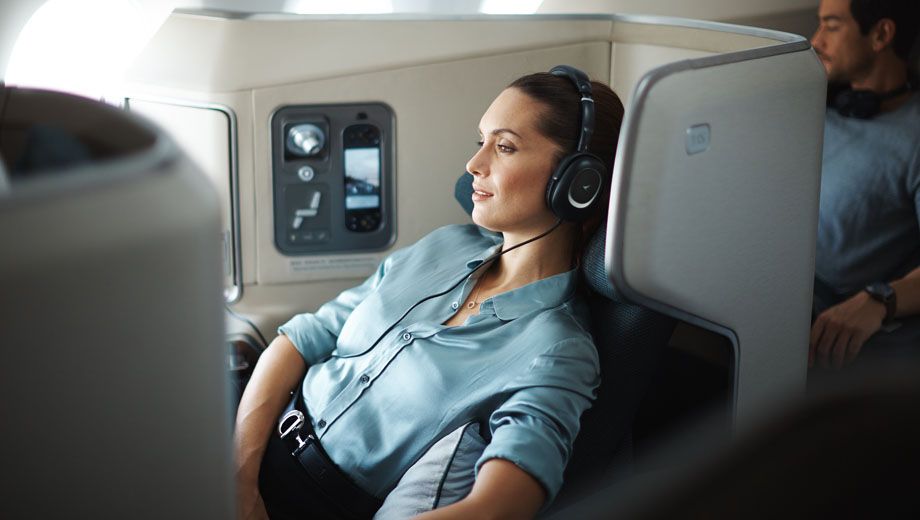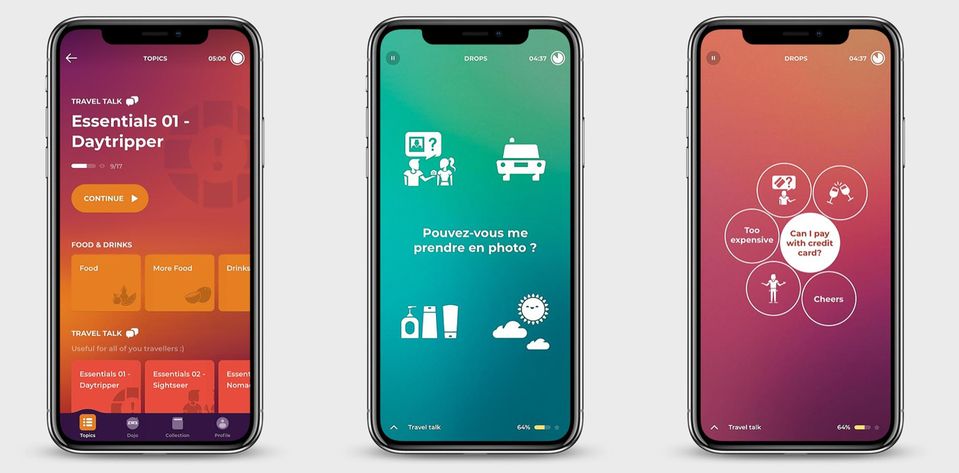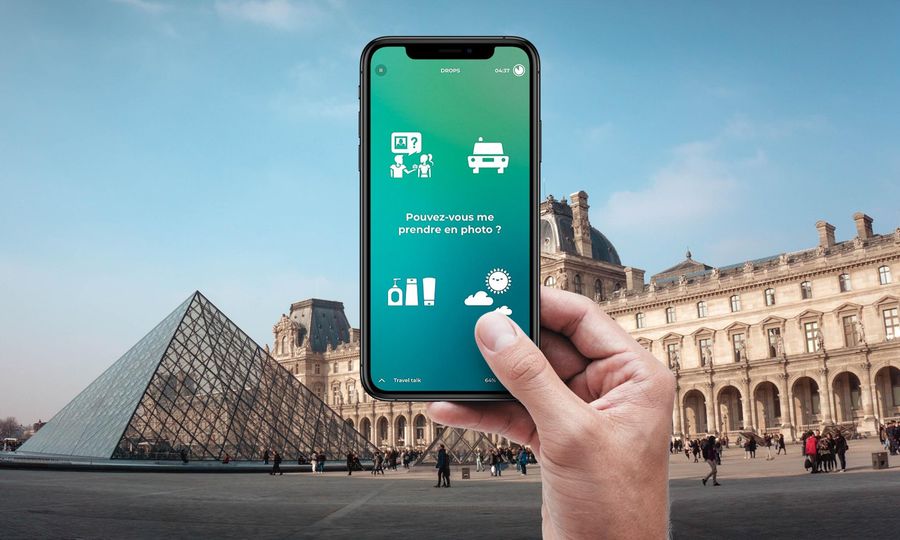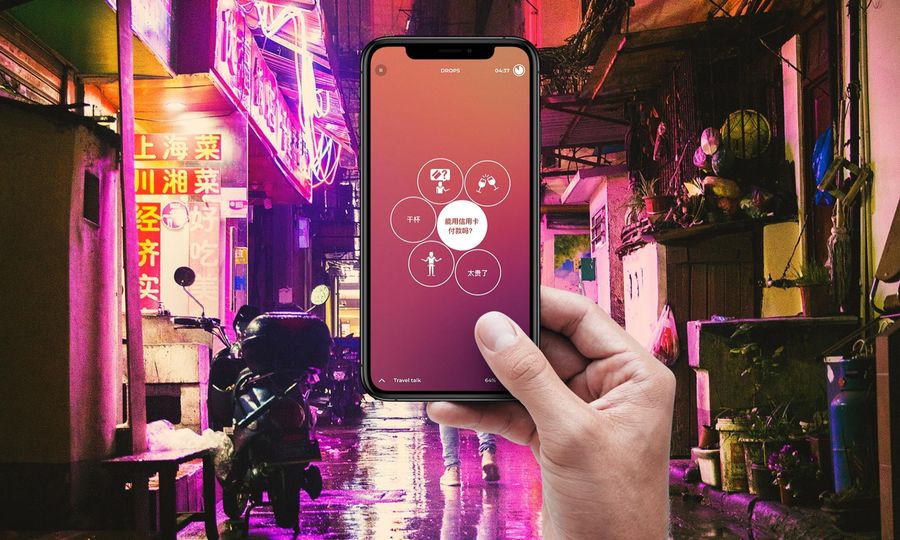Can this app help you learn a new language during your next flight?

By next year, the language-learning app Drops will be loaded into seat-back entertainment systems around the world. But will its Travel Talk feature actually have you speaking like a local?
“Buenas noches; ¿cómo estás?; ¿eres de aquí?” Three phrases into a date in Barcelona, and things were going well. Then I blanked. A qué te… a qué te… I’d forgotten how to ask “what do you do?” in Spanish.
As I madly scrolled through the Drops language app on my phone, my date patiently sipped a beer, then asked “Ummm, how about we just switch to English?."
For the past two weeks, I’d been practicing Spanish, including both Latin American and Castilian dialects, on the Drops app, specifically testing out an early version of the platform’s just-launched feature called “Travel Talk.”
Travel Talk promises to teach me “essential words and phrases travelers need to get around,” thus bridging “the gap between casual language learning and fluency, allowing [travelers] to better connect with locals and immerse themselves in the culture of their destination.” It was a tall order.
Putting Travel Talk to the test
Like many trying to learn a new tongue, I’d sampled an array of options – Duolingo, podcasts, online tutoring, even attending a cringe-worthy class called “Sing Along with Spanish” – and nothing had stuck.
Drops, whose game-like approach uses visual mnemonics to help users learn words and phrases, seemed a promising next try.
Since debuting in 2015, the app has been downloaded by more than 12 million users, and nabbed Google Play’s Best App of 2018.
Additionally, it now has the weight of an in-flight entertainment leader behind it. A new partnership with Global Eagle Entertainment will put Travel Talk in front of millions of travelers monthly, starting in the first quarter of 2020. Global Eagle is responsible for 70% of entertainment systems globally on cruise ships and airlines (105 and counting), with a 90% market share for seat-back gaming, according to the company.
The app’s 33 languages include indigenous languages such as Samoan, Hawaiian, Icelandic, and Maori in addition to such big guns as German and French. The Travel Talk feature is available for 25 languages, with more to come.
Learning the lingo
The graphics are simple and clean. And since you match images to words and phrases by swiping, rather than typing on a keyboard, it would make sense for an in-flight experience. As you progress, a series of games and mazes help reinforce the word or phrase, which is repeated by a native speaker after each "play."
“The Drops audience is for someone who is starting to learn language and wants to build up vocabulary,” says Drew Banks, the company’s chief customer officer.
“With Travel Talk, we’ve created a category for tourists, business travelers, and exchange students, who can learn to communicate in short, useful phrases that go beyond the app’s basic vocabulary.”
If that sounds like a gamified version of those classic Lonely Planet phrasebooks, you’re not far off.
While the free version of the app doesn’t put Travel Talk behind a paywall, there’s a daily time limit, and you must unlock the categories one by one.
I used the premium version (US$9.99 monthly, US$69.99 yearly, or US$159.99 for a lifelong subscription), which allowed unlimited access to the dozen-odd Travel Talk categories, among them “Meet and Greet,” “Buy and Bargain,” “Eat & Drink,” and “Meet the Locals.”
I began with Travel Talk’s four “Essentials” categories, tailored to the Daytripper, Globetrotter, Nomad, and Sightseer - though there didn’t seem to be a difference among them.
I liked that I could skip basic words and phrases I already knew (hello, yes, no, thank you) by swiping upward, allowing me to focus on terms I found more useful (excuse me, no problem, how much, speak slowly). And though the word games were varied, after a 15-minute session – which is adjustable, from five minutes to unlimited – I found the repetition tedious and began to lose interest.
Well, it turns out that’s because I was using the app all wrong.
When cramming isn't the answer
“Our free version limits you to just five minutes per day, and there’s reason for that,” says Banks. “It’s a learning method called spaced repetition. Your brain needs time between sessions, so you can review and absorb the material. Plus, it’s better for your overall digital health.”
I soon realized that such bite-sized sessions wouldn’t magically catapult me to conversational fluency.
And the app’s focus on building vocabulary at the expense of grammar seemed quite limiting in terms of real communication. (Especially frustrating was the lack of verbs.) But Banks points to studies that show that learning 2,500 words gets you to 80% to 85% comprehension of a language.
“Ours is a building-block approach that gets you in the habit of language-learning,” says Bank. “The goal is to help build comprehension, which in turn improves your confidence level. But for the next level, grammar and conversation, you’ll need to work with a teacher for fluency. We don’t believe any language app can get you there.”
So realistically, how much time will it take to confidently learn what’s presented in Travel Talk?
“It’s a personal thing,” says Banks. “We expect people will practice on the plane ride over, picking up around 10 phrases so when they land, they can communicate.”
I see his logic: On the way to a foreign country, a motivated traveler could theoretically cram in 10 useful phrases, as each category takes around 10 minutes, depending how many phrases/words you decided you want to practice. (For example, if you don't care about learning the foreign word for 'credit card', you could skip it.)
But given the aforementioned attention limits, it seems implementation of Travel Talk is more of a chance to experiment with it on the flight; if you like it, you can download the Drops app in your hotel room to continue learning.
If, like me, your goal is to learn a single language, the free version is worth it for helping to build vocabulary, but you’ll need to temper your expectations about becoming more conversationally fluent.
For example, in my testing of Castilian Spanish “Essentials”, the term paired with “go away” is déjame, but according to my local friends, most would say vete. Not wrong, per se – it’ll get your point across even if the nuance is lost. (A user is able to flag anything that seems as if the translation isn’t exactly right.)
A larger limitation is that unlike, say, Duolingo, there is no pronunciation feature, so you aren’t able to practice speaking skills.
But for frequent leisure or business travelers who plan to visit several different countries and want to quickly learn key words and phrases in a number of languages, the app’s Travel Talk category is ideal – and here’s where you might want to consider upgrading to premium for unfettered access.
As for my romantic rendezvous in Barcelona? We met up a second time, but “por favor,” my date begged, “can we just speak English tonight?”




Hi Guest, join in the discussion on Can this app help you learn a new language during your next flight?